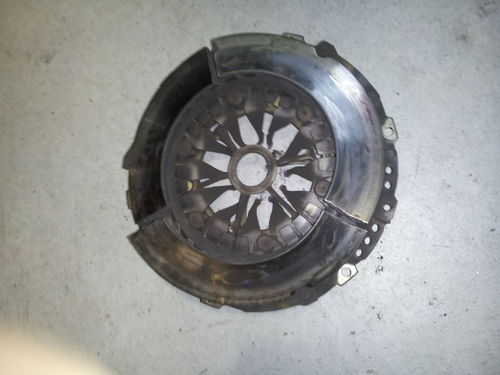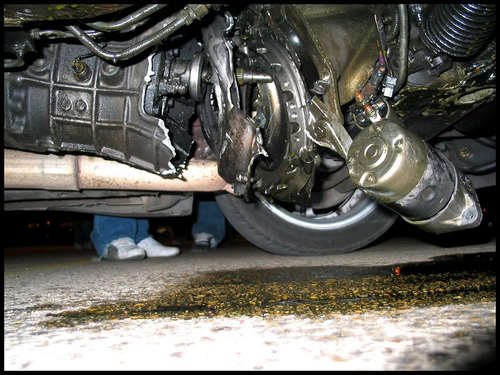Welcome To VW Clutch Failure
Catastrophic Clutch Failure at 16,000km
I was taken back when my fathers Skoda Octavia had a clutch failure at 16,000km. The car has only ever been driven by himself a 67 year old man, and his wife 66 years old. Both have a history of driving manual cars since the day he got his licence. In my 37 years of knowing them both I can only recall one clutch failure when I was 5 and my father was towing a caravan up a steep hill in an old kingswood (and the car had done far in excess of 100,00km).
VW australia have claimed that the clutch failure was due to user error or abuse. They are yet to confirm there position in writing as of the 24th of August 2012
I am a Mechanical Engineer ( I mention this because legally I can stand in a court of law to testify) with 14 years industry experience some of this time was spent in the automotive industry doing power train and chassis design. In addition to my professional experience I race cars in group 3J improved production.
The Photo two the right shows the catastrophic failure that has occured to the 16000km young skoda running a VW/Audi 1.8 litre TSI engine and five speed gearbox with a dual mass flywheel. This car was bought at the end of 2009 as the "good car" the car gets babied around hence the 16,000km in almost 3 year.
To repair this failure cost $3500 which is over 10% of the car original cost.
I have given VW Australia the opportunity to correct there position, however they are steadfast in there claim that this is a user fault.
My Analysis of What Happened
Before I looked at the parts the dealer stated "I have never seen a skoda with a clutch failure at or before 16000km" I asked "have you ever seen a clutch failure at 16000km?" he stated "No"
The flywheel itself shows signs of failure i.e. exessive movement in the dual mass fly wheel. This may be caused due to heat, i.e. heating of the flywheel failing the internal components resulting in excessive play. All clutch systems produce some heat and design should be capable of adressing the environment that it is used in. VW australia are claiming this is due to driver error or abuse. I find this very difficult to belive since the driver is 67 and has driven manuals his whole life without such failures.
There is plenty of life left in the pressure plate with the friction material well above the rivets. Typically clutch plate failure as a result of abuse would be burning of the clutch friction surface to the point where it no longer exists.
Imagine if disc brake rotors were designed to fail before the brake pads! Customers would not be happy having to constantly replace the rotors while the pads had not worn out.
2 years before he bought this car he bought a manual nissan pulsar, this car has done in excess of 100,000km and still on its first cluch. This is what you normally would expect out of a clutch. Keep in mind these are driven by the same people.
I am picking up the parts tommorrow 25/8/2012 to conduct further analysis and get a second opinon before I approach VW under the Trade Practices Act as advised by Victoria Consumer Affairs.
I not only see this as a consumer affair but as a Safety Concern. If pressure plates can come appart like that at virtually idle (when the failure occured the driver was pulling away from traffic lights) the damage it could cause at 6000rpm would be devistating.
Failed Skoda Pressure Plate
Above is a photo taken of the skoda's pressure plate. Notes of intrest is that yes it is broken into three pieces. In my years of automotive engineering and racing I have never seen a pressure plate come apart like this. Such a failure at high engine revs could easily result in pieces flying through the bellhousing and in the worst case scenario pass into passenger compartment.
VW australia have claimed this failure was caused by user abuse/error at 16,000km. I can only assume they are suggesting the clutch slipped to the point that the metal overheated, resulting in overheating and brittle fracture of the pressure plate due to heat cycling. One only hopes that they don't build there brakes in the same material or design.
What Can Happen When a Rotating Mass Lets Go!
To the right is an image of a skyline whith a failed flywheel. This shows what can happen when a rotating mass comes apart at high revs. The remants of the flywheel are non existent in the photo as they are scatered on the road and embeded in his bonnet.
When this happens make sure you tuck you legs up so they don't get chopped off
Is This a Common Occurance?
Research on the Internet would suggest this happens regularly to VW group's Dual Mass Fly Wheels. This would indicate that it doesn't take a lot of heat before failure of the flywheel starts to occur.
Typically VW tends not to warranty the issue rather make more money through repairs. It is very easy to point at a flywheel and say look hot spots (note most flywheels will have a blue tinge every if only fitted for 1000kms, such is the nature of a friction interface which implies heat). However new Consumer Affair Laws recently introduced backing the customer by ensuring products have a valid life before failure (unfortunately it does not apply in this situation as the car was bought before the law was introduced in Jan 2011). I would suggest with normal driving one should expect a life well over 100,000km out of a clutch.
So please let me know if you have had a VW group car with a clutch failure, email me your story and I will put it on this site.

